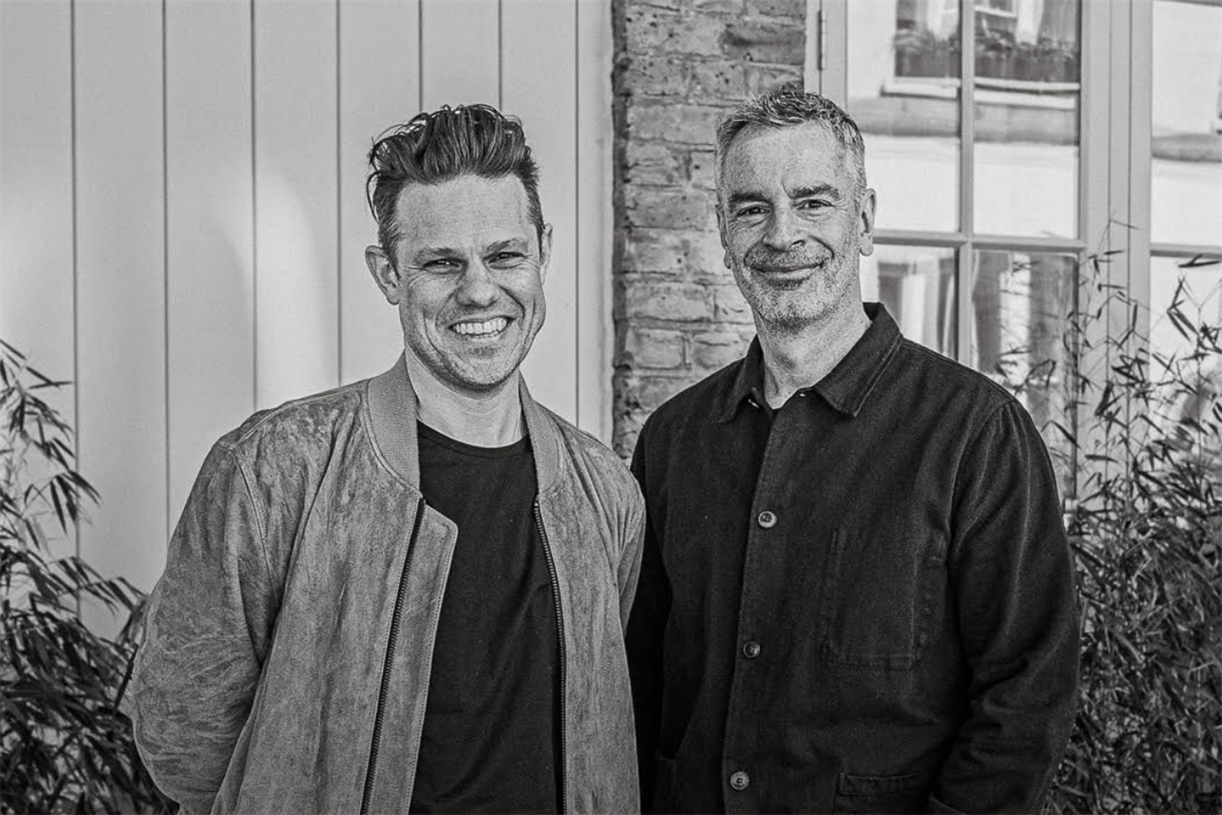IKEA’s Marketing Strategy: How IKEA Serves Culture & Connection
IKEA is one of the most recognizable brands in the world—not just for its flat-pack furniture, but for the full experience it creates around everyday life. IKEA has built a brand on culture, comfort, and connection, turning shopping into...
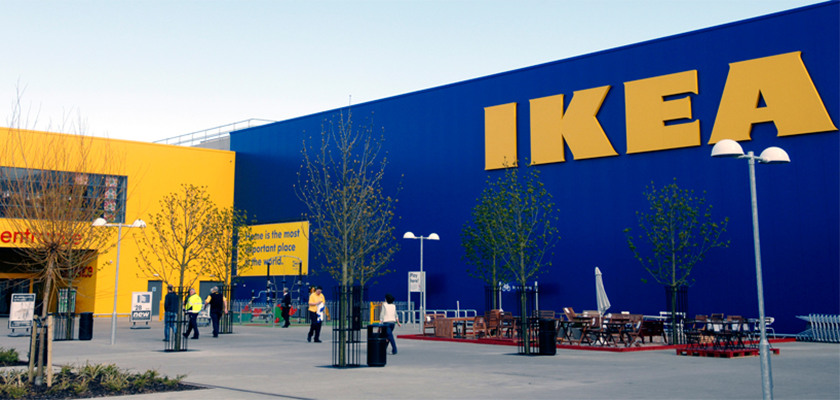
IKEA is one of the most recognizable brands in the world—not just for its flat-pack furniture, but for the full experience it creates around everyday life.
IKEA has built a brand on culture, comfort, and connection, turning shopping into a spatial experience shaped by food, storytelling, and even unexpected trends like IKEA dating.
So, behind its global success is a marketing strategy that goes far beyond products and pricing.
From Swedish meatballs to interior designs that inspired generations, IKEA has consistently delivered more than just home furnishings. The company has embraced digital transformation and social media marketing while holding onto the cultural roots that make its stores feel like a slice of Sweden. And thanks to clever campaign moments and organic word-of-mouth, it has remained relevant across platforms, generations, and continents.
In this article, I’ll take a deep dive into IKEA’s marketing strategy—both digital and experiential—and highlight examples that show how the brand turns showrooms into adventures, customers into ambassadors, and simple spaces into something far more meaningful.
What You’ll Learn About IKEA’s Marketing?
Target Audience of IKEA Visualization at Its Finest: IKEA Catalogs IKEA Restaurants as a Tool for Marketing IKEA Dates 💙: The Power of WoM Marketing Design as Storytelling IKEA’s Marketing Mix (4Ps) SWOT Analysis of IKEA IKEA’s Digital Marketing Strategy Social Media Content BrandTarget Audience of IKEA
When it comes to IKEA’s target audience, the brand has a broad demographic appeal, but it generally focuses on middle-class consumers who are budget-conscious and looking for affordable yet stylish home furnishings.
In particular, IKEA’s target audience includes young adults and families who are setting up their first home, as well as those who are looking to upgrade or refresh their existing living spaces, as Marques Thomas states. The company’s emphasis on functionality and practicality also makes it a popular choice for college students, renters, and people who live in smaller homes or apartments.
IKEA has been known to appeal to environmentally conscious consumers, as the company emphasizes sustainability in its products and operations. By offering affordable, eco-friendly options, IKEA has built a loyal following among those who are passionate about reducing their carbon footprint and making responsible choices.
Visualization at Its Finest: IKEA Catalogs
Since 1951, printed catalogs have been the most famous and maybe most important part of IKEA’s promotion strategy.
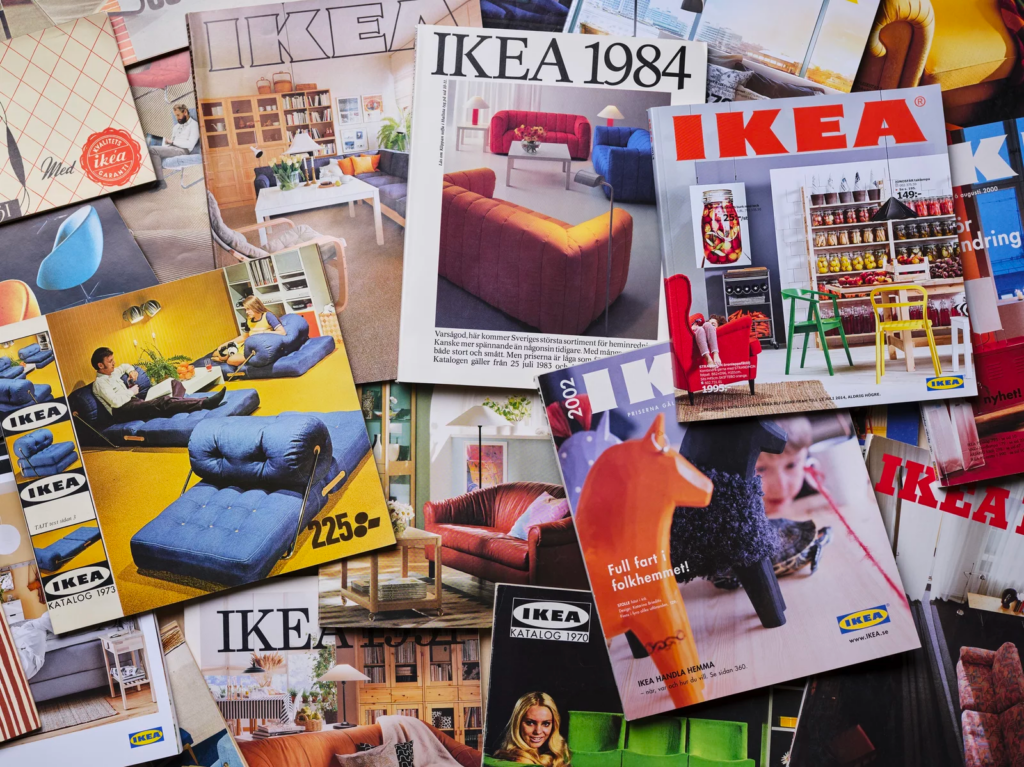
IKEA catalogs were distributed to millions of households for years until 2021. Since then, IKEA has been following the digital path of sharing inspirational in-real-life design examples. You can find the latest IKEA catalogs on its website, and on the IKEA museum, you can explore every IKEA catalog ever created!
In short, IKEA has expanded its digital marketing efforts to connect with its target audience, especially after ending the era of printed-on-paper IKEA catalogs. As social media platforms like Instagram and Pinterest are the new publishing presses and magazine sellers, the Swedish furniture giant IKEA chooses to focus on using them. IKEA has a strong presence where it shares images of its products and offers design inspiration to followers.
IKEA Restaurants as a Tool for Marketing
IKEA’s relationship with food started in 1953, when founder Ingvar Kamprad served coffee and biscuits at the brand’s first furniture showroom in Älmhult.
Customers who were fed stayed longer, felt more at ease, and ultimately bought more. That insight shaped what would become one of the world’s largest restaurant chains.
By the 1960s, full-service restaurants like IKEA Baren opened inside stores, and by the ’80s, IKEA had developed its now-famous Swedish meatball recipe.
Today, the food offering goes far beyond that! From plant-based options like veggie balls and salmon from certified sustainable farms, to UTZ-certified chocolate and coffee. Customers can also shop at the Swedish Food Market or grab a snack at the Bistro.
But beyond increasing visitor comfort, what do the IKEA restaurant and Swedish Food Market offer from a marketing perspective?
👉More than 700 million people eat at IKEA each year. And food is still treated as part of the experience, not the profit center.
It’s part of the brand experience. The restaurant and market help IKEA do something no product tag can: immerse people in the culture behind the company.
You’re not just shopping—you’re tasting Sweden.
From a plate of meatballs to a jar of marmalade or a bag of frozen cinnamon buns, the food makes the visit feel like more than a retail errand. It becomes an adventure.
IKEA Dates 💙: Power of WoM Marketing
One of IKEA’s most unexpected (and most charming) organic marketing wins came from its in-store restaurants—specifically, how they quietly became go-to date spots.
Over time, people started recommending IKEA as a low-pressure, affordable, and memorable place for a first date. It was casual, public, and came with meatballs.
People have been creating content about it across social media platforms. Here’s a fan art piece for an IKEA date, posted on X (formerly Twitter):
ideal IKEA date 👽🦈 pic.twitter.com/Wp5YmWt0qz
— lanylevendula (@LanyLevendula) February 6, 2025Another example of how IKEA restaurants turn people into brand ambassadors is shown below:
The brand never officially promoted it—but it didn’t have to. Word-of-mouth did the rest. Can you see how widespread it’s become?
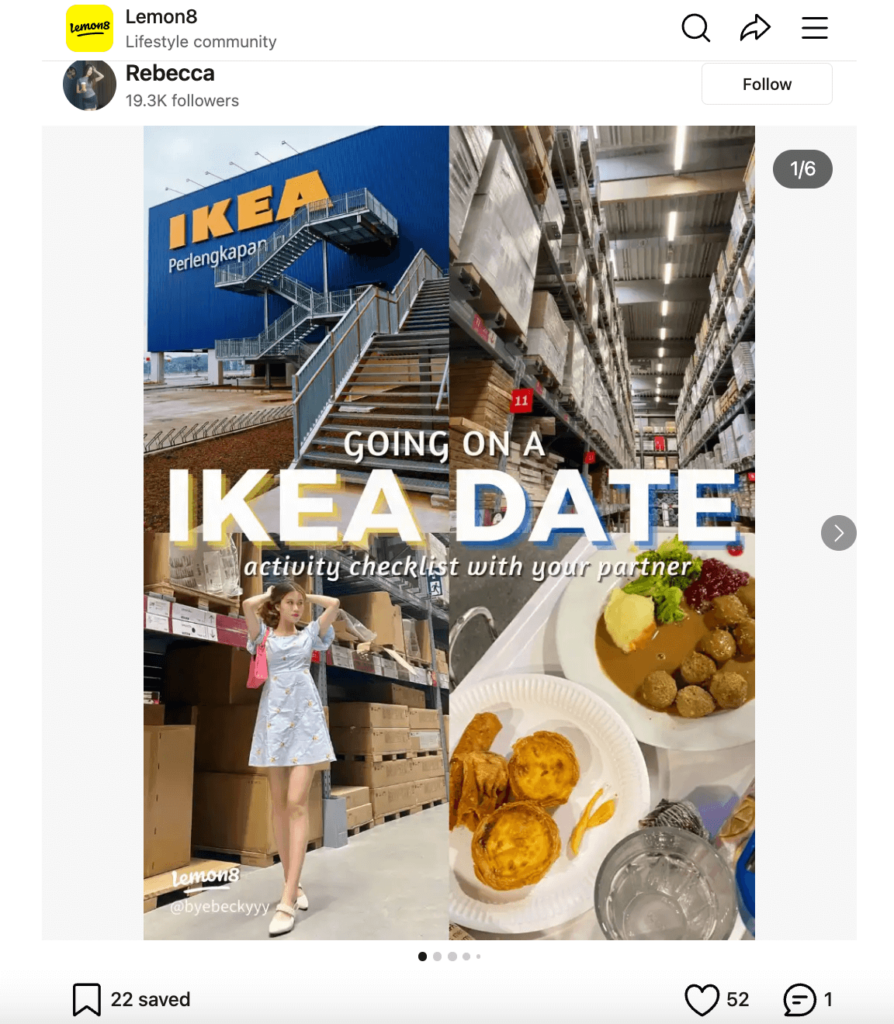
Image source: https://www.lemon8-app.com/@byebeckyyy/7194770644951941633?region=my&pid=website_seo_share
Dating at IKEA became a low-key trend, especially among Gen Z and millennial audiences looking for something different from the usual café or bar.
IKEA leaned in gently, sharing playful social content and letting the community build the story for them. It’s a smart example of how real customer behavior can evolve into brand value—no heavy-handed campaign required.
Design as Storytelling
One of the brand’s most quietly powerful strategies is showing who designed a product and why. From the official website to stores, IKEA regularly highlights the designer’s name, shares their inspiration, and gives a glimpse into the thinking behind the piece.
It’s subtle, but it’s intentional -and it’s marketing.

IKEA makes mass-produced items feel authentic, reinforces credibility and craftsmanship, and creates an emotional hook for the customer by sharing info like who the designer is, what they think in their designing processes, and what they look like.
Most furniture brands focus on the end result. IKEA tells the story behind it.
By doing this, the brand turns flat-packs into something personal and thoughtful, designed by real people for real homes. This design-first storytelling doesn’t just build emotional value, it differentiates IKEA in the market.
It also supports IKEA’s larger marketing playbook:
It fuels content creation through interviews, design stories, and behind-the-scenes features It encourages word-of-mouth, because people love sharing products that come with meaning And it reinforces IKEA’s values: accessibility, transparency, and democratic designIKEA’s Marketing Mix (4Ps)
IKEA’s approach to product, pricing, placement, and promotion is practical, consistent, and always connected to real customer needs.
Let’s break down how the brand handles the classic 4Ps.
Product
IKEA offers a wide range of ready-to-assemble furniture and home accessories, all designed with simplicity, function, and affordability in mind.
IKEA products are modular and often serve multiple purposes; for example, the BRIMNES bed comes with built-in storage.
IKEA’s product range is nearly identical across the globe, which helps make the brand accessible and familiar worldwide. No matter which IKEA store you visit, you’ll find the same iconic pieces—like the BILLY bookcase, the POÄNG armchair, and the LAMPAN table lamp.

Price
Implementing a cost-leadership strategy, IKEA ensures its products are priced competitively. By optimizing supply chains and encouraging customer participation in assembly, the company reduces costs, passing the savings onto consumers.
Pricing decisions are made early in the product development process, with teams working backwards from a target price to determine materials and production methods.
This price-first approach allows IKEA to maintain affordability across product lines while staying profitable. In addition, the company uses global scale and standardization to keep price points consistent, especially for its core range of bestsellers.
Place
With a global presence, IKEA operates large-format retail stores in strategic suburban locations—but that’s only one part of its growing retail model.
The brand is now expanding into city-centre planning studios, improving its online shopping experience, and increasing access through home deliveries and services.
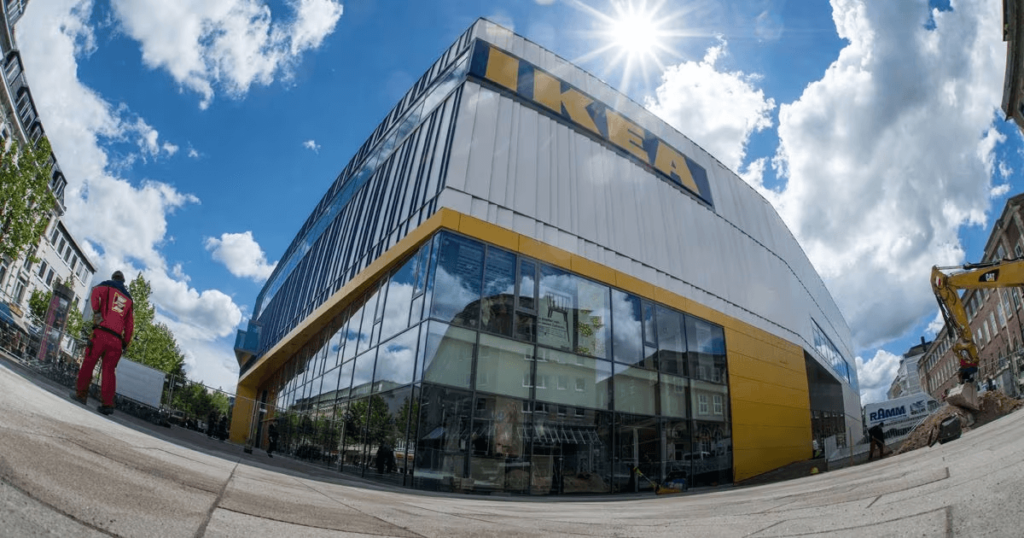
As the company puts it, this is “the IKEA way of retail”: bringing the brand closer to customers through a mix of traditional and digital touchpoints. The integration of these channels ensures a seamless, flexible shopping experience no matter where or how people choose to shop
Promotion
IKEA uses a mix of traditional and digital promotion to stay top of mind across generations.
While it still invests in TV spots and outdoor ads, its digital campaigns often steal the spotlight. In one, IKEA slid into users’ DMs with a playful “U up?” message and gifted free mattresses to some respondents, turning late-night phone habits into clever marketing.
SWOT Analysis of IKEA
IKEA’s market position is backed by a strong business model, but like any global brand, it faces both internal limitations and external risks.
Here’s a breakdown of its strengths, weaknesses, opportunities, and threats, supported by current insights and industry observations from academic research.
Strengths
IKEA’s biggest strength lies in its ability to offer stylish, low-cost furniture without compromising on perceived value. Its flat-pack, ready-to-assemble model keeps logistics costs low while reinforcing a brand identity centered on practicality, simplicity, and smart design.
Beyond products, IKEA delivers a holistic brand experience. Every store doubles as a cultural hub—complete with Swedish restaurants, curated showrooms, and the Swedish Food Market—turning a visit into something closer to a lifestyle immersion than a typical shopping trip. This spatial experience builds emotional connection and makes customers stay longer, explore more, and come back.
The brand also stands out through its storytelling-first approach to design. By spotlighting the individual designers behind key products—sharing their names, inspirations, and creative processes—IKEA brings a human touch to even its most affordable items. This adds emotional value and strengthens the sense of authenticity that defines the brand.
With ultra-modern stores in global markets, a highly integrated supply chain, and growing digital capabilities, IKEA continues to deliver consistent brand experiences across locations. Combined with volume-driven strategy and sharp pricing, this has fueled strong revenue and profitability growth in recent years.
Weaknesses
While IKEA’s suburban megastores support its flat-pack format, they often sit outside city centers, making accessibility harder for urban dwellers. The long lead times for new store planning can also limit expansion agility.
Additionally, IKEA has faced criticism around product durability and furniture safety, particularly as consumer expectations for sustainable and long-lasting goods rise. But it’s also worth noting that they offer a 10-year warranty on certain types of furniture, like couches.
Opportunities
IKEA has strong momentum in emerging markets, where demand for affordable, design-forward furniture continues to grow. There’s also potential in local sourcing of raw materials to reduce supply chain risks and align with sustainability goals.
As consumers shift to e-commerce and flexible pickup formats, IKEA’s investment in online shopping, city-center planning studios, and services like “Click & Collect” positions it well for future growth.
The brand can also further strengthen its identity by highlighting its sustainability efforts in marketing and packaging.
Threats
The rise of furniture rental startups and low-cost e-commerce competitors—like Wayfair and Amazon—is putting pressure on IKEA’s market share. Price wars and diversification by established competitors could erode customer loyalty if IKEA doesn’t continue to innovate.
Additionally, regulatory challenges and entry barriers in underdeveloped markets can slow expansion. As preferences shift toward personalized and modular design, the brand must keep evolving without losing its core value proposition.
IKEA’s Digital Marketing Strategy with Examples
When it comes to digital marketing, IKEA utilizes a variety of channels to effectively reach and engage its target audience. Below are some of the key digital marketing channels that IKEA utilizes to connect with its customers:
IKEA‘s Social Media Strategy
In its early days, social media was considered to be a passing fad, a distraction to be avoided. But today, it’s almost an essential part of our daily lives. Each of the social media channels has a high potential for companies and businesses to meet consumers.
It’s important to know which platforms your customers use and to be there at the right time to reach and connect with them. It makes your brand imperative and valuable in their eyes. You need to make good use of it.
IKEA does it very well. Its social media marketing strategy focuses on posting discounts, news, and events on social media accounts. Its social media teams are very responsive and quickly return to any customer complaints.
IKEA’s social media campaigns are a key player in their marketing; the brand invites website visitors to join the brand in sharing posts and getting more and more likes.
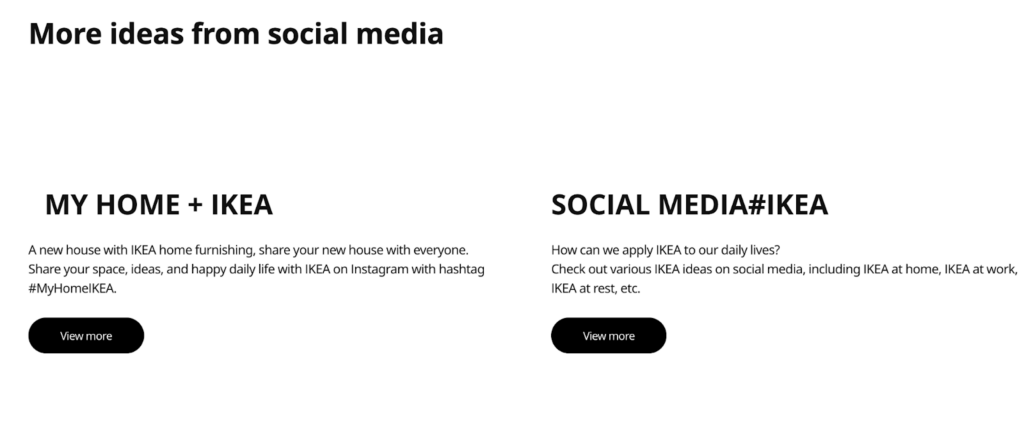
IKEA’s motivating attitude generates buzz on social media, especially on Instagram:

As you can see in the visual above, Instagram users create well-thought mise en scenes and share their photos with IKEA hashtags making their posts visible to the ones looking for inspiration.
IKEA’s Square Metre Challenge is another example of how successful IKEA’s social media campaigns are. This time, IKEA chooses YouTube as its main social media channel, promotes tiny living spaces, and demonstrates how they can be more practical and useful.
Content Strategy of IKEA
Content marketing keeps a significant place in IKEA’s digital marketing strategy. For example, IKEA USA’s Home Tour Series videos on Youtube are brilliant examples of IKEA’s effective use of content marketing.
If you are looking for opportunities to benefit from the power of the digital world, such as killing it on social media as IKEA does, our selection of the best digital marketing companies is ready to guide you!
Brand Strategy of IKEA
IKEA’s brand strategy is focused on delivering a consistent and compelling brand experience to its customers, one that is rooted in the company’s values and purpose while also meeting the practical needs of its target audience. By prioritizing quality, affordability, and sustainability, IKEA has established itself as a trusted and beloved brand among consumers around the world.
The company’s purpose is to create a better everyday life for its customers, and this is reflected in everything from its product design to its marketing messaging. IKEA also has a strong value proposition, offering affordable yet stylish home furnishings that are designed with functionality and sustainability in mind.
From stores to online, IKEA always shares creative ideas and tips that can be useful or inspiring when designing homes. Therefore, IKEA sets itself apart from other furniture brands by going beyond the role of a mere furniture seller. IKEA becomes a design advisor or a friend, giving ideas and inspiration.
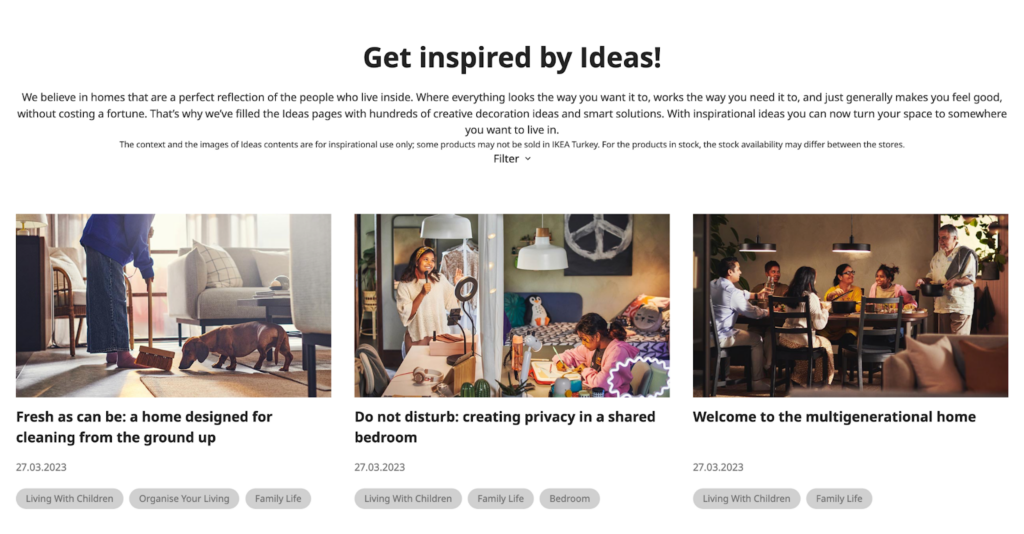
Wrapping Up
As companies continue to shift their focus to online channels, many lessons can be learned from IKEA’s digital marketing campaigns and strategy. Whether you’re up to promoting your products or connecting with your customers, IKEA’s approach offers valuable insights.
If you are looking for more inspiration to develop a solid digital marketing strategy, you are at the right place! We’ve tons of blog posts explaining how famous brands make themselves unforgettable in the digital world. So, you can learn how humor can be the key to success on social media platforms from Netflix’s digital marketing strategy, how to transform your brand into an inclusive one from our insights into Adidas’s digital marketing strategy, and more!

 ValVades
ValVades 












